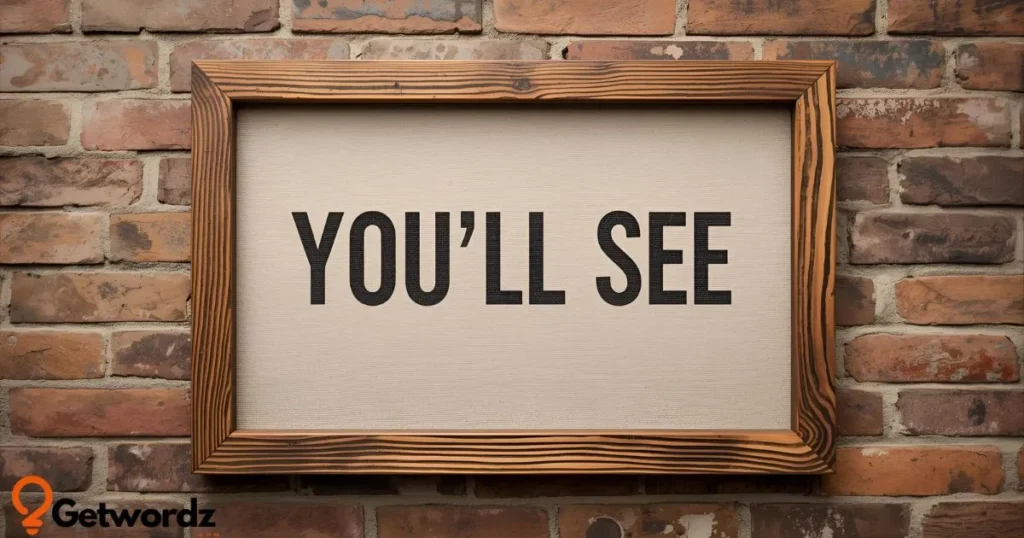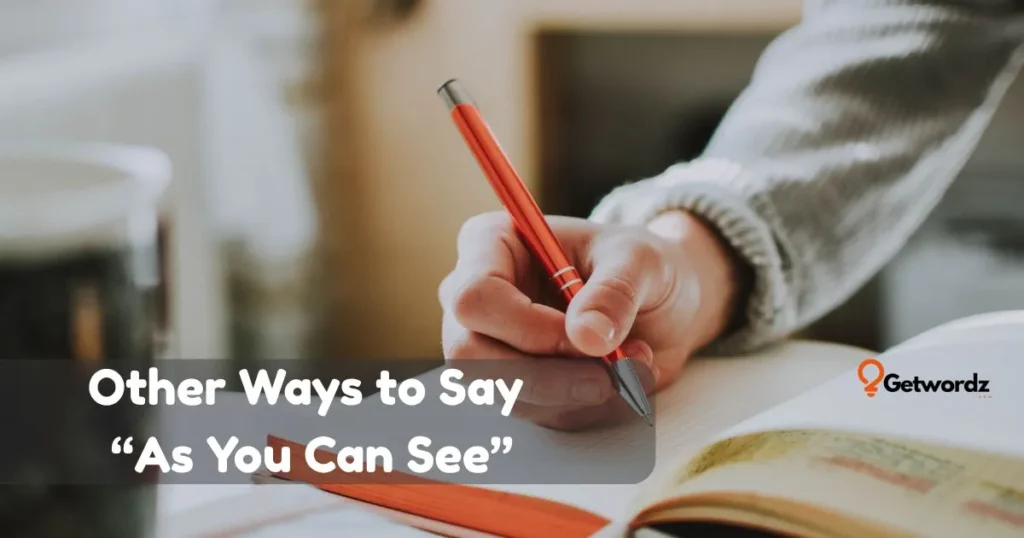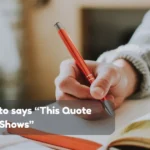“As you can see” is a common phrase people use when pointing out something obvious, explaining an idea, or highlighting a detail, but let’s be honest, it can feel repetitive and uninspired when used too often.
When you’re writing an email to a colleague, explaining a point in class, showing something to a friend, or even making a case in a presentation, relying on the same phrase over and over can make your communication sound dull or predictable. That’s why so many people search for different ways to say “as you can see”, they want more creative, natural, and impactful expressions that fit a variety of situations.
From personal experience, I’ve noticed how much better conversations flow when you switch up your wording. Instead of sounding like a broken record, you can choose phrases that feel professional with coworkers, warm with family, fun with friends, or even thoughtful with a partner.
The good news is, there are plenty of unique expressions, creative alternatives, and better wording choices that can help you sound more engaging, authentic, and relatable.
In this post, I’ll share a carefully curated list of fresh alternatives to “as you can see”, perfect for emails, essays, everyday conversations, and even funny responses when you want to add a touch of personality.
👉 Ready to upgrade your vocabulary and find the perfect phrase for any setting? Let’s dive in.
1. Clearly
Scenario: Imagine you are in a meeting and want to emphasize a point on a chart without sounding repetitive. Instead of saying “As you can see on the graph” you can use “Clearly” to make your message sound sharper and more confident.
Explanation: Clearly is a strong professional alternative to as you can see. It works well in formal emails, reports or presentations where you want to highlight facts without overexplaining. It is also a natural fit in conversations when pointing out something obvious. Using this phrase is a better way to say, a creative alternative and a different wording that feels fresh and assertive.
Examples:
- “Clearly the results show our campaign was successful.”
- “You cannot deny it. Clearly this movie is a fan favorite.”
- “Clearly we need to rethink our weekend plans if it rains.”
Why It Works: Clearly is direct, versatile and concise. It signals confidence and helps you communicate facts without sounding repetitive. This makes it one of the best unique expressions to replace as you can see in both professional and casual contexts.
2. Evidently
Scenario: You are writing a blog post or report and want to highlight something that is obvious from the data. Instead of repeating as you can see, using “Evidently” gives your writing a polished and formal tone.
Explanation: Evidently carries a slightly more academic or professional tone. It suggests that the evidence speaks for itself, making it a refined better way to say as you can see in research papers, essays or persuasive arguments. It is one of those creative alternatives that build credibility while avoiding redundancy.
Examples:
- “Evidently customer satisfaction increased after the new policy.”
- “He was evidently thrilled about the surprise.”
- “Evidently the team worked hard to deliver results on time.”
Why It Works: This phrase elevates your language while keeping it clear and professional. It is a unique expression that signals authority and makes your communication more persuasive and polished.
3. As Shown
Scenario: When sharing slides during a presentation or pointing to a chart in class “As shown” is a smooth alternative that feels natural and direct.
Explanation: As shown is a slightly formal phrase that works especially well in visual contexts. It emphasizes what is being displayed, whether in graphs, charts, photos or examples. It is one of the most common different ways to say as you can see in academic and business writing.
Examples:
- “As shown in the diagram, energy usage decreased by 20%.”
- “The new design is more efficient as shown in these results.”
- “As shown here we have made significant progress.”
Why It Works: This alternative is short, clear and fits perfectly in visual explanations. It avoids redundancy while keeping your tone professional, making it a go-to better wording choice for presentations and reports.
4. Notice
Scenario: Suppose you are texting a friend about a new haircut or sharing a funny detail in a photo. Instead of typing as you can see, using “Notice” feels casual, playful and conversational.
Explanation: Notice is less formal and more engaging. It invites the listener or reader to pay attention to a detail, making it an excellent creative alternative for personal conversations, social media captions or lighthearted emails. It is a unique expression that makes everyday language sound more lively.
Examples:
- “Notice how the cat completely ignored me in this video?”
- “Notice the difference in style between the two outfits?”
- “If you notice closely, the solution was there all along.”
Why It Works: This phrase draws attention naturally without sounding stiff. It is versatile enough for humor, storytelling or casual chats, making it a better way to say as you can see in everyday communication.
5. You’ll See

Scenario: You are talking to a partner about an upcoming surprise or building suspense in a group chat. Instead of saying as you can see, “You’ll see” creates intrigue and curiosity.
Explanation: You’ll see it has a playful, sometimes flirty tone. It is a unique expression that works when you are hinting at something exciting or leaving space for discovery. It is not just a different wording but also a creative alternative that changes the mood of your message.
Examples:
- “Trust me you’ll see why this restaurant is my favorite.”
- “You’ll see how amazing the concert was once I share the videos.”
- “Don’t worry you’ll see everything works out fine.”
Why It Works: Unlike the straightforward as you can see this phrase sparks anticipation. It is flexible enough to be fun, teasing or reassuring which makes it perfect for personal conversations where you want to keep things engaging.
6. It’s Obvious
Scenario: You are explaining something to a classmate and want to highlight a detail that everyone can recognize. Instead of saying as you can see you can use “It’s obvious” to keep your tone clear and straightforward.
Explanation: It’s obvious that it is a casual and confident phrase. It works in both conversations and writing when you want to show that the point needs no further explanation. This phrase is a better way to say as you can see because it feels natural and avoids sounding repetitive.
Examples:
- “It’s obvious the team worked hard on this project.”
- “It’s obvious she enjoys being around her friends.”
- “From these results it’s obvious the strategy was successful.”
Why It Works: This phrase is direct and easy to understand. It makes communication more natural and conversational, making it one of the most creative alternatives to use in casual or semi-formal settings.
7. Clearly Visible
Scenario: You are showing someone a chart, picture or design. Instead of saying as you can see you can use “Clearly visible” to draw attention to a specific detail.
Explanation: Clearly visible is a slightly formal phrase that fits well in presentations, reports and descriptions. It highlights something that can be easily observed. It is a unique expression that works well when describing visual evidence.
Examples:
- “The difference is clearly visible in this side-by-side comparison.”
- “The excitement was clearly visible on his face.”
- “The progress is clearly visible in the updated results.”
Why It Works: This alternative helps you describe visuals without sounding repetitive. It is precise, professional and a better wording choice for both spoken and written communication.
8. As Demonstrated
Scenario: You are giving a presentation and pointing to an experiment or example. Instead of repeating as you can see you can use “As demonstrated” to make your point stronger.
Explanation: As demonstrated, it has a formal and professional tone. It is often used in academic writing, reports and speeches where you want to show evidence or proof. It is one of the most reliable ways to say it as you can see in structured communication.
Examples:
- “As demonstrated by the data, our approach is effective.”
- “As demonstrated in this experiment the hypothesis is correct.”
- “As demonstrated here, practice really improves results.”
Why It Works: This phrase emphasizes evidence and proof. It is authoritative, clear and works especially well in academic and professional settings, making it a strong creative alternative.
Related Post: 30 Other Ways to Say “Thank God” With Examples!
9. From This
Scenario: You are explaining a result or outcome. Instead of saying as you can see you can use “From this” to connect the evidence with your explanation.
Explanation: From this is a simple and flexible phrase. It allows you to link a fact, picture or observation to a conclusion. It is an easier way to say it as you can see without sounding formal or repetitive.
Examples:
- “From this we can understand how the process works.”
- “From this it is clear she values honesty.”
- “From this you can tell the plan was well thought out.”
Why It Works: This alternative is short and direct. It works in both casual and professional contexts and is a unique expression that keeps language natural.
10. Observe
Scenario: You are teaching a group of students or guiding a colleague through a process. Instead of saying as you can see you can use “Observe” to make the instruction clear.
Explanation: Observe is a slightly formal word that encourages someone to pay attention. It is useful in academic, instructional or even creative settings. It works as a creative alternative because it sounds direct and purposeful.
Examples:
- “Observe how the colors blend together in this painting.”
- “Observe the change in tone when the character speaks.”
- “Observe how the system reacts under pressure.”
Why It Works: This phrase is engaging and instructional. It helps guide attention in a way that feels intentional and professional, making it a better wording choice for teaching, training and explaining.
11. Take a Look
Scenario: You are chatting with a friend or showing a family member something on your phone. Instead of saying as you can see you can use “Take a look” for a warm and casual touch.
Explanation: Take a look is informal and friendly. It is a unique expression that works best in everyday conversations, texts and social media. It is one of the most natural creative alternatives to use in relaxed settings.
Examples:
- “Take a look at this photo. Isn’t it amazing?”
- “Take a look at the new design we created.”
- “Take a look at this video. It’s hilarious.”
Why It Works: This phrase feels inviting and personal. It creates a sense of connection and is easy to use in many contexts, making it a better way to say as you can see when speaking casually.
12. Clearly Shown
Scenario: You are explaining a diagram or pointing to results in a report. Instead of saying as you can see you can use “Clearly shown” to highlight the visual evidence.
Explanation: Clearly shown has a professional and formal tone. It is a better wording choice for academic writing, presentations and technical explanations. It draws focus to evidence without sounding repetitive.
Examples:
- “The improvement is clearly shown in this chart.”
- “The results are clearly shown in the following example.”
- “The growth is clearly shown in the quarterly report.”
Why It Works: This phrase highlights evidence in a precise and confident way. It is a creative alternative that works best when you want to sound professional and fact-based.
13. Without a Doubt
Scenario: You are talking with colleagues about project results and want to emphasize certainty. Instead of saying as you can see you can use “Without a doubt” to sound confident and assured.
Explanation: Without a doubt is casual yet strong. It adds conviction to your point and works well in professional conversations as well as friendly discussions. It is a creative alternative and a better way to say as you can see when you want to remove uncertainty.
Examples:
- “Without a doubt the team delivered excellent results.”
- “Without a doubt this is the best choice for us.”
- “Without a doubt she is the most dedicated member of the group.”
Why It Works: This phrase communicates confidence and certainty. It is versatile enough for formal or casual use and makes your point stronger, which makes it a unique expression worth using.
14. As Illustrated
Scenario: You are showing a graph in a presentation or a picture in a classroom. Instead of saying as you can see you can use “As illustrated” to highlight the example.
Explanation: As illustrated has a formal tone and is commonly used in academic or business contexts. It is a different wording that directs attention to visual support. It works well in reports, studies and professional slides.
Examples:
- “As illustrated in the diagram our model is effective.”
- “As illustrated here the method leads to better results.”
- “As illustrated by the data customer engagement is growing.”
Why It Works: This phrase clearly links evidence with explanation. It is professional, polished and a better wording choice that shows authority and clarity.
15. Plainly
Scenario: You are making a point in a debate or discussion and want to show that the truth is easy to recognize. Instead, as you can see, you can use “Plainly.”
Explanation: Plainly is simple and direct. It is an older but still effective word that highlights clarity. It is a unique expression that can work in writing, speeches or even casual conversations where you want to emphasize the obvious.
Examples:
- “Plainly this policy is not working.”
- “Plainly he enjoys his new role.”
- “Plainly the evidence supports our claim.”
Why It Works: This alternative is straightforward and impactful. It avoids filler and makes your message sound confident, which makes it a creative alternative to use in different situations.
16. As Evidenced
Scenario: You are writing a report or essay where you need to highlight proof. Instead of saying as you can see you can use “As evidenced” to sound formal and authoritative.
Explanation: As evidenced is a formal phrase that links evidence to your explanation. It is often used in research, case studies and legal or academic documents. It is a better way to say as you can see when you need credibility.
Examples:
- “As evidenced by the results the treatment was effective.”
- “As evidenced here the system operates as intended.”
- “As evidenced in the study the theory is correct.”
Why It Works: This phrase provides authority and trust. It is polished, professional and a creative alternative that adds weight to your argument.
17. As Reflected
Scenario: You are sharing performance feedback or business results. Instead of saying as you can see you can use “As reflected” to describe how outcomes appear.
Explanation: As reflected is a semi-formal phrase that ties outcomes to evidence. It is a different wording that works well in reports, presentations and reflective writing.
Examples:
- “As reflected in the numbers, sales improved this quarter.”
- “As reflected in her actions she is dedicated to the cause.”
- “As reflected in the feedback, customers value our service.”
Why It Works: This phrase connects performance with visible outcomes. It is professional yet flexible, making it a better wording choice in business or academic use.
18. Clearly Stated
Scenario: You are presenting information and want to point out that it has already been mentioned. Instead of saying as you can see you can use “Clearly stated.”
Explanation: Clearly stated has a formal and authoritative tone. It is a creative alternative that works in essays, instructions and speeches. It signals that the message is already clear to the audience.
Examples:
- “Clearly stated in the policy the rule applies to everyone.”
- “Clearly stated in the manual the step must be repeated twice.”
- “Clearly stated in the report the findings are accurate.”
Why It Works: This phrase underscores transparency and clarity. It is direct, formal and a unique expression that improves professional communication.
19. It’s Clear
Scenario: You are talking with a friend, a partner or a colleague and want to emphasize something simple. Instead of as you can see you can use “It’s clear.”
Explanation: It’s clear that it is casual but flexible. It is one of the most natural ways to say it as you can see in both casual and professional contexts. It communicates simplicity without sounding formal.
Examples:
- “It’s clear she enjoys spending time with her team.”
- “It’s clear the new design is more effective.”
- “It’s clear we need to make a few changes.”
Why It Works: This phrase is short, conversational and adaptable. It makes communication smoother and is a better wording choice that avoids sounding repetitive.
20. Look At
Scenario: You are chatting casually or showing someone a photo or a design. Instead of as you can see you can use “Look at” to make your words sound relaxed and inviting.
Explanation: Look at is informal and friendly. It is a creative alternative that works well in everyday conversations, messages and social media. It feels natural and expressive.
Examples:
- “Look at this sunset. Isn’t it beautiful?”
- “Look at how happy they are in this photo.”
- “Look at the difference after the makeover.”
Why It Works: This phrase is casual, personal and engaging. It is a unique expression that makes your tone warm and relatable, perfect for friends, family and casual audiences.
21. As Depicted
Scenario: You are presenting an image, chart, or infographic in a professional setting. Instead of as you can see you can say “As depicted” to highlight what the visual shows.
Explanation: As depicted has a formal and polished tone. It is a better way to say as you can see when referencing visual materials. It is often used in reports, research, and presentations.
Examples:
- “As depicted in the chart sales have grown steadily.”
- “As depicted here the system functions smoothly.”
- “As depicted in the study results were positive.”
Why It Works: This phrase feels professional and precise. It is a unique expression that signals accuracy and clarity in contexts where visuals provide evidence.
22. From This Evidence
Scenario: You are making a case in a debate, presentation, or essay. Instead of saying as you can see you can use “From this evidence.”
Explanation: From this evidence emphasizes proof and logic. It is a creative alternative that works in formal and persuasive contexts, especially when linking facts to conclusions.
Examples:
- “From this evidence we know the policy is effective.”
- “From this evidence it is clear she is highly skilled.”
- “From this evidence the project is worth supporting.”
Why It Works: This phrase strengthens credibility and highlights proof. It is a better wording choice when you want to make arguments more authoritative.
23. As Displayed
Scenario: You are pointing out a slide in a presentation or sharing product images in a meeting. Instead of as you can see you can say “As displayed.”
Explanation: As displayed has a semi-formal tone. It is one of the different ways to say as you can see when visuals or materials are central to the explanation.
Examples:
- “As displayed in the report profits increased.”
- “As displayed on the screen the process is simple.”
- “As displayed in the example results are consistent.”
Why It Works: This phrase keeps your communication clear and professional. It is a unique expression that avoids redundancy and connects directly to visual evidence.
24. As Refers
Scenario: You are writing or speaking about a concept that has already been mentioned. Instead of as you can see you can use “As refers.”
Explanation: As refers is slightly formal and works when pointing back to an earlier example or concept. It is a creative alternative for structured discussions and essays.
Examples:
- “As refers to the earlier point teamwork is essential.”
- “As refers to the data our plan is sustainable.”
- “As refers to the chart the strategy works.”
Why It Works: This phrase connects explanations to earlier points. It is a better wording choice that helps with flow and clarity in professional writing.
25. You Can Tell
Scenario: You are chatting with a friend, colleague, or partner and want to highlight an observation. Instead of saying as you can see you can use “You can tell.”
Explanation: You can tell is casual and conversational. It is a unique expression that works well in personal talks, emails, and even social media captions.
Examples:
- “You can tell he really enjoyed the concert.”
- “You can tell this cake was made with care.”
- “You can tell the team put effort into the project.”
Why It Works: This phrase feels personal and warm. It is a better way to say as you can see in casual contexts where connection matters more than formality.
26. It Shows
Scenario: You are pointing out results or explaining changes in a situation. Instead of saying as you can see you can use “It shows.”
Explanation: It shows is short, casual, and flexible. It works as a creative alternative in conversations, reports, and stories.
Examples:
- “It shows that hard work pays off.”
- “It shows how much progress you’ve made.”
- “It shows the difference a new strategy can make.”
Why It Works: This phrase is clear and easy to understand. It is a different wording that adds simplicity and confidence to your point.
27. It’s Evident
Scenario: You are speaking in a meeting or writing an essay where you want to highlight something clear. Instead of as you can see you can use “It’s evident.”
Explanation: It’s evident is formal and confident. It is a better wording choice that works well in academic, professional, and persuasive settings.
Examples:
- “It’s evident the new approach is effective.”
- “It’s evident she cares about her work.”
- “It’s evident this design is user-friendly.”
Why It Works: This phrase adds authority while staying simple. It is a unique expression that makes your point sound reliable and trustworthy.
28. As Made Clear
Scenario: You are referencing something explained earlier. Instead of saying as you can see you can use “As made clear.”
Explanation: As made clear is semi-formal and works when linking evidence to conclusions. It is a creative alternative in essays, reports, or debates.
Examples:
- “As made clear in the report the strategy succeeded.”
- “As made clear by the example the plan works.”
- “As made clear in the study collaboration improves results.”
Why It Works: This phrase adds emphasis and certainty. It is a better way to say as you can see when you want to show that the evidence is undeniable.
29. It’s Apparent
Scenario: You are having a conversation or writing a review. Instead of saying as you can see you can use “It’s apparent.”
Explanation: It’s apparent strikes a balance between casual and professional. It is a different wording that highlights something obvious without sounding too formal.
Examples:
- “It’s apparent she loves what she does.”
- “It’s apparent the movie was made with care.”
- “It’s apparent the changes improved performance.”
Why It Works: This phrase communicates clarity in a polished way. It is a unique expression that works across casual and professional settings.
30. As Highlighted
Scenario: You are writing a report or giving feedback. Instead of as you can see you can use “As highlighted.”
Explanation: As highlighted has a formal tone and emphasizes a key point. It is a creative alternative and a better wording choice in academic, business, and professional writing.
Examples:
- “As highlighted in the summary the method is effective.”
- “As highlighted earlier, teamwork is the key to success.”
- “As highlighted in the discussion the issue must be addressed.”
Why It Works: This phrase helps you draw attention to important details. It is professional, clear, and one of the best unique expressions to use in structured communication.
Pros and Cons of Using “As You Can See”
Pros
- ✅ Clear and direct – It immediately points out something obvious, making communication straightforward.
- ✅ Widely understood – Because it’s common, readers and listeners easily grasp the meaning without confusion.
- ✅ Flexible across contexts – Works in casual chats, professional emails, and even presentations.
- ✅ Emphasizes evidence – Often used to draw attention to visuals, facts, or results, making your point stronger.
- ✅ Quick and natural – A simple phrase that fits into everyday conversation without overthinking.
Cons
- ❌ Overused phrase – Can sound repetitive or lazy if used too often, reducing impact.
- ❌ Lacks creativity – Doesn’t stand out compared to unique expressions or creative alternatives.
- ❌ Not always inclusive – Assumes the audience can “see” something, which may not apply in all cases.
- ❌ Too casual for some settings – In formal writing or speeches, you may need better wording choices.
- ❌ Reduces engagement – Repetition of the same phrase may make your communication feel dull or less thoughtful.
Closing Words
As you can see, having a variety of fresh alternatives keeps your language engaging and helps you avoid falling back on repetitive or overused phrases. This list of unique expressions and creative alternatives gives you better wording options to fit every mood, from casual chats to professional notes.
You can use these different ways to say the phrase when writing to colleagues, posting on social media, or even adding a thoughtful touch in cards and messages to friends or family.
Try slipping one of these fresh wording choices into your next email or conversation, you might be surprised how naturally it makes your communication stand out.
By choosing better ways to say as you can see, you’ll come across as more authentic, thoughtful, and impactful.
So, the next time you want your words to connect, reach for a smarter phrase instead of the usual as you can see.




